Beijing Feb.. 22 & 23, 2017
In advance I apologize for misspellings of names, but access to the Internet to check them is very slow and I have to pay for this slowness. Also, there is so much to tell, I will not be surprised if you decided to just glance at this. China is a fascinating country, from the time in grade school when I looked at pictures of peasants working in rice paddies to now is a long trip, for me and for China.
The morning that we were to leave the ship for an overnight in Beijing we were greeted with snow on the veranda and tales of the Indonesian, Philippine, and Indian crew making snowmen and snow angels on the open deck on the 10th floor. The location guide (someone who has a vast knowledge of all our ports and shares it with us), a veteran of 20 years of sailing including the Antarctic, remarked that this was the first time that she ever saw crew assigned to snow shovel duty.
Not only snow, but fog. We were scheduled to leave the ship at 7:45a, but at 7a the captain came on the PA system to inform us that the Chinese government had closed the highways due to fog and snow and we could not leave… Fortunately, that was lifted about an hour later and we were only an hour late leaving. We were supposed to see the Great Wall in the morning and then have lunch. I don’t know who planned this, but they had very little grasp of geography because it was a 5 hour trip, not 3 hours, from the ship in Xingang port (near Tianjin port) to the Wall. The seats on a Chinese bus are smaller even than coach in an airplane and were not too comfortable.
On the trip there it was still foggy outside and the bus windows were so filthy that we did not see much besides fog and flat land. When we made a rest stop the driver had to get out and manually wash the outside of the windshield – no automatic washers. Of course that does clean the entire window… Because we complained, while we were climbing/exploring the Great Wall, he cleaned all the windows making the rest of the bus rides a more visual experience.
They are very serious about not driving and drinking with severe penalties. An offense results in losing your driving license for 5 years and if I recall correctly some jail time. There are many signs around to remind one.'
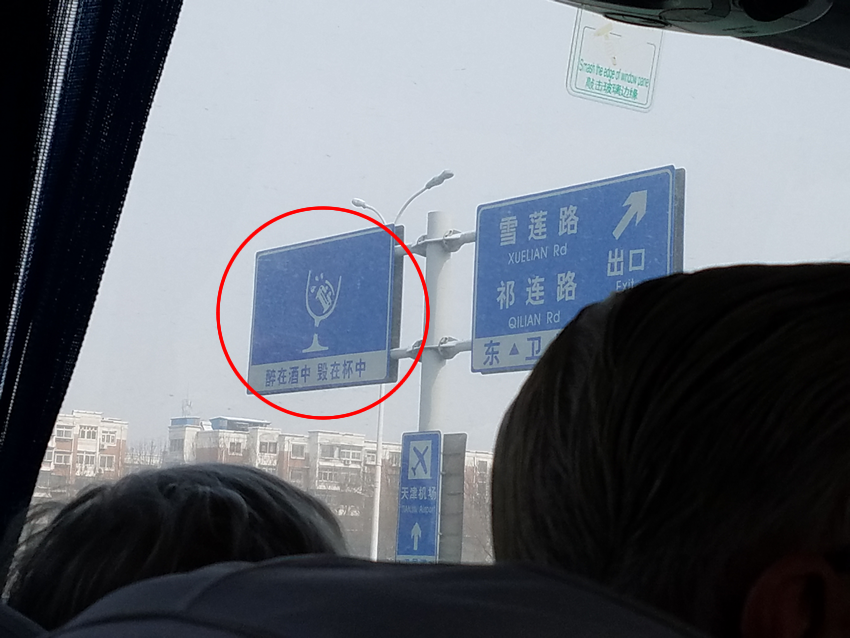
Visit to the Great Wall
The part that we visited is in the Yen mountains. We went to the Badaling Gate which has changed a lot in the 13 years since I last saw it. Instead of being able to drive close to the entrance, the parking lot is a good 10 minute walk from the entrance. A walk that is lined with shops; a welcome change from the vendors who use to stalk you.
The temperature was in the 20s and there was no sun… To make it even more difficult, the wind was blowing 50 to 60 mph (this is not an exaggeration) I don't know what magnetism the Great wall exerts, but there is a primeval urge to climb. And I did! I managed to climb ¾ of the way towards the fourth tower (circled below). After the third tower the railing that I was gripping together with using a cane to pull my way up became a good 9 inches lower making it more difficult. I made the mistake of looking back and realizing that all those steps that I climbed had to be taken back down… The wind was so strong that I did not dare to let go and take a picture.
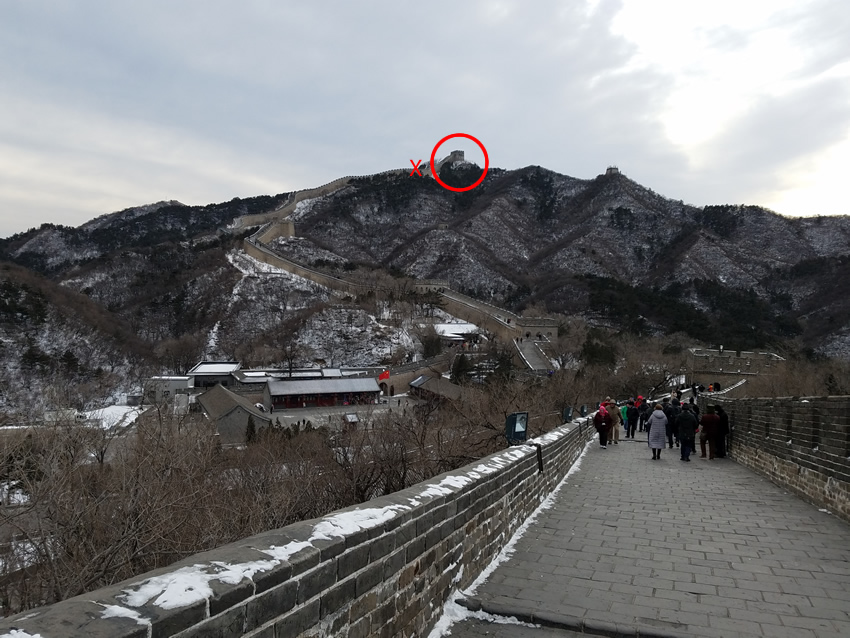 The X The X marks as far as I got before common sense took over.
The X The X marks as far as I got before common sense took over.
With the wind trying to separate me from the railing, I managed to turn around and start the harder trip of going down. I was afraid that I would be blown over and tumble down those stone steps, but I made it. On the trip down there were many places where I faced the wind. Then it blew tiny snow crystals into my face that produced a stinging sensation. After I was finally down, and breathing more normally, I had to traverse a pedestrian“tunnel” that was essentially a wind tunnel. At times I turned around to avoid those crystals, and fought to keep standing. There was no railing to cling to. Finally, I reached the Badaling Coffee Shop where we were meeting befor going into Beijing. There I finally had warmth and no wind! But I am glad that I had a chance to do the climb. As we were driving away, the sun came out and it was beautiful.
Background of the Great Wall
When we refer to the “Great Wall” we are thinking of the one built during the Ming Dynasty which was constructed from 1368 to 1644. There were other walls in China, most of which were built north to south instead of east to west like the “Great Wall.” The earliest one was built 2800 years ago and known as the Chin Wall after the Chin Dynasty. It did not have not towers and was intended only as a barrier to horses so was not as high as the Great Wall.
Few of the Chinese dynasties built walls around the country. They were strong militarily and instead of war they used diplomacy. Potential enemies to the north wanted the agricultural products and silk abundant in the South while the north had horses and furs desired by the south. Instead of wasting time and money in military engagements they reached trade agreements.
There are several myths associated with the Wall that are not true.
1) It is NOT visible from space.
2) It is not continuous for 3000 miles
3) It did not protect China
The construction material is whatever was available locally. Thus it may be built of earth in some places, clay in others or stone when that was available. There is a tower at least every 300 yards. These towers were used to billet soldiers, store material, and communication. Using smoke or light signals a message could be sent 300 miles in half a day, a miracle for that time. In places where the Mings felt vulnerable to invasion the Wall was 5 meters high and 5 meters wide. There are places where there is no wall, but instead straight peaks, that are inaccessible to an invading army. But there may still be a tower there to preserve the communication ability.
Building the wall caused the downfall of the Ming Dynasty because it bankrupted them. The peasants were highly taxed and forced labor was used to build the wall. If a worker died, he was simply buried in the wall. Consequently, there was a peasant revolt and they simply opened the gates and allowed the “enemy” of the Mings to enter.
As an aside there is a story told about a woman whose husband was a laborer on the wall. When winter came she bundled up some warm clothes to take to him. On arrival at the wall, she was told that her husband was dead and had been buried in the wall. Hearing this she stood in front of the wall and cried whereupon the wall broke and revealed the body of her husband. When the emperor heard about this he had her come to the capital to meet him. After the meeting, he decided that he wanted to marry her. She agreed if he could meet several conditions. There must be a proper burial for her husband, the emperor must attend the ceremony, and he must build a tall tower to honor her dead husband. The emperor, wanting very much to marry her, agreed to all these things. At the funeral, she climbed to the top of the tower and yelled down to him, “You are a tyrant, an awful person and stupid.” Then she threw herself off the tower and died.
In most of the past, the Chinese never regarded the wall as great and just referred to it as “the wall.” In some areas the farmers took the stones from the wall to build terraces for farming. It was foreigners who decided that it was great. It was never represented in Chinese art, history, or writing. Anything written about it was negative until Richard Nixon visited and stated, “This is a great wall and it had to have been built by a great people.” The Chinese loved that and made the wall a symbol of the Communist party. Now the practice of using parts of the wall in farming is prohibited and the farmers are being asked to return what they have.
BEIJING
Although not treated well after the Boxer Rebellion and during the Red Guards rampage, Beijing, has not been destroyed in any recent war. Despite its history it is a mixture of old and new. Some sections, especially those around the Forbidden City, are old, but the feeling of modernity amidst ancient times remains. The architecture in many of the buildings is so different from the square buildings that we build. Round cylinders, reverse pyramids, and other different shapes make an interesting city scape.
Traffic is very impatient. You may be crossing the street at an intersetion with the light, but the cars turning into that street are loathe to stop and you have to hold your own.
One big difference between what we saw in China 13 years ago and now is the trucks. Back then, the sides of the trailer on the 18 wheelers were canvas. Now they are solid, like ours. And the bike lanes have been taken over by cars. We saw very few bikes vs. 100s of them the last time. Given the pollution difficulty Beijing has, there are rules about when cars can be driven depending on the numbers on your license plate. We saw very few Chinese cars – they sell those to Vietnam. The Chinese spend a great deal of money on expensive cars such as BMWs and other foreign cars. To drive a Chinese car is to “lose face.” Despite over 60 years of communism, this concept is very alive. The guide reported that his wife, a section chief in some government agency, has a subordinate who has a car despite it being a 10 minute bike ride to work and 30 minutes by car due to the difficulty in finding a parking place. But, now the wife has to have a car to avoid “losing face.”
That evening in Beijing we had Peking Duck which I enjoyed. There was also many other foods brought out and placed on the lazy susan that is the centerpiece of all Chinese tables. I liked the duck because you wrapped it up in a VERY thin crepe and could eat it in hand. Chopsticks for me work for about two bites, then they refuse to meet. And the food is not easy to eat with a fork which they provide for these backward Westerners – even 4 year olds can use chopsticks…
Because we were so late due partly to the weather, partly to a 2 hour underestimation of the time from the port to the Wall, after dinner we saw the end of a Chinese opera at the hotel. We missed the “singing,” which to Western ears, even some who like Western Opera, can be described as not terribly pleasant. We did see acrobatics dramatized as combats, one with swords, another with two knives against a sword, and then hand to hand.
The next morning, as if to apologize for the cold cloudy day before, dawned bright and sunny with blue sky – not quite as bright as Japan. I don’t know if one could see the ground from 20,000 feet, but 13 years ago on a day like this (although it was May and warmer) we could not see the ground when it was like this…
Breakfast was served in the hotel. To us it looked like a dinner. There were Chinese guests there and they heaped their plates full of vegetables, noodles and many other things. Most of us were a little more circumspect and found some Western food – labeled “Non-H…. (something meaning not Chinese), although not too much. I did try Hawthorne juice and found that I liked it very much. It is supposed to be very good for the digestion.
On the way to the Forbidden City we passed the Beijing City Hall. It was about 8A and our guide said that when it opens at 10A there will be a long line outside for citizens who have a complaint. But…when you finally get to talk to someone, he or she tells you, “This will take a while, we have to find out what is really going on.” And of course “while” never comes and things remain the same.
Another landmark we passed was Mao’s Mausoleum. The guide said that he visited once, but that he had to stand in line for several hours, then when he was finally admitted the guards pushed him through saying, “Hurry up,” so that he had barely 20 seconds to see Mao's remains.
There is a story told about a Chinese citizen who stood in line for hours to get in, then after seeing the remains, got in line again. He did this two more times. Someone said, "You must really be a fan of his." He replied, "No, I just want to be sure that he's dead."
The Forbidden City
The Forbidden City was built from 1406 to 1420. It consists of 980 buildingsand covers 72 hectares (over 180 acres). When it was built the emperor who was familiar with tunnels did not want anyone tunneling in. To prevent this he built a wooden blockade of 15 stories below the compound consisting of 8 crosswise layers of wood, interspersed with 7 lengthwise ones.
The entire compound is HUGE. The status of the occupant of a building could be told by the number of animals carved into the ends of a roof besides the customary dragon that keeps out evil spirits. The emperor had 9 and no one could have 9 or more except him. At the time that it was built there were no trees visible above this enclave because nothing could be higher than the emperor. Today not only are there trees visible, but skyscrapers in other parts of the city. It was first opened to the public in 1925. More than 80 percent of the palace is now accessible to visitors, up from 30 percent in 2012. 2020 marks the palace's 600th anniversary.
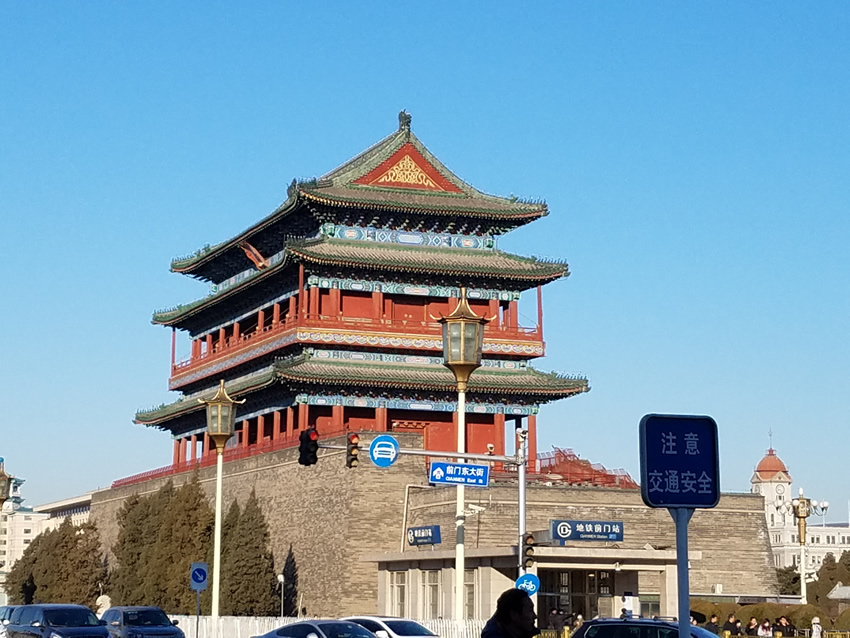
Note, this is just an entrance to the Forbidden City and is not a building. Instead it is an archery tower. Should an enemy breach the city wall, archers would shoot from here.
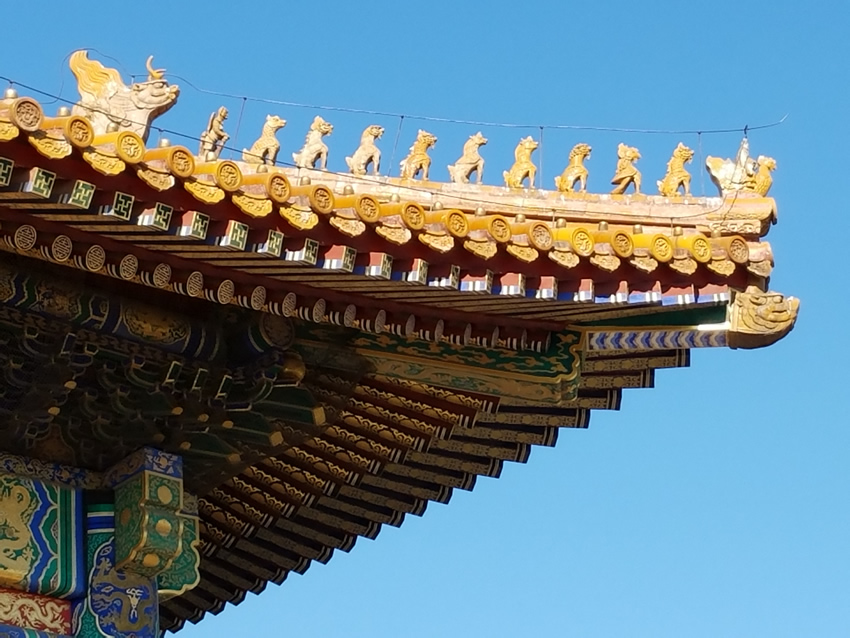
The roof corner of the Emperor's House. I don't know what the far left figure with the animals is...
We went to the Forbidden City on our last trip, but they have opened so much since then. Every four to six years they repaint all the old buildings, so much of the bright work is very fresh. There was only one area that looked ready for that paint job. The picture below is such a small part of the Forbidden City that I hesitate to post it. In short the Forbidden City defies photography. There are long low buildings on either side of this building and other similar courtyards are beyond it. It just never quits/ But several thousand people lived here during its heyday.
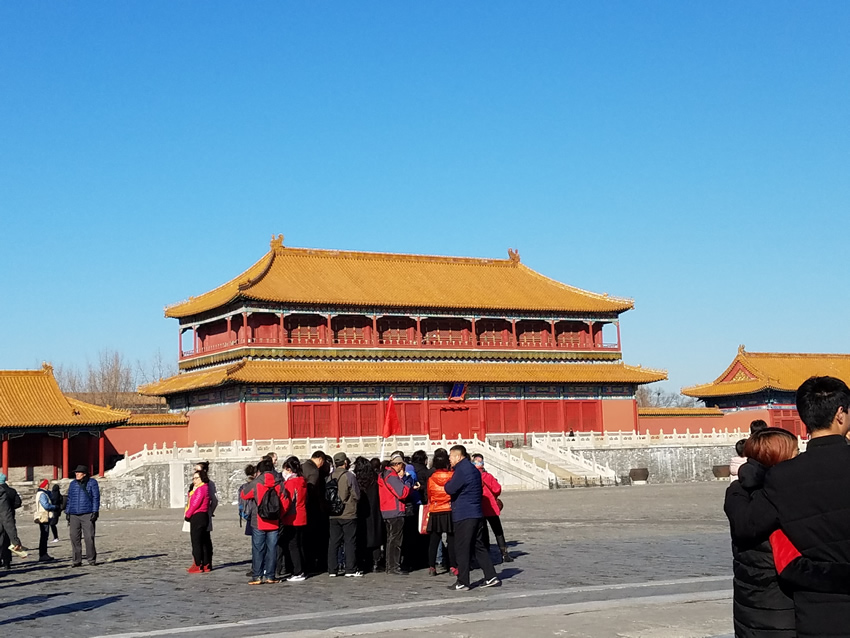
The garden was something else! The emperor at the time it was created, had visited southern China and become enamored with a garden there and wanted it recreated in Beijing. And it was! The limestones that make up these “Sculptures” were brought to Beijing on the Grand Canal from southern China.
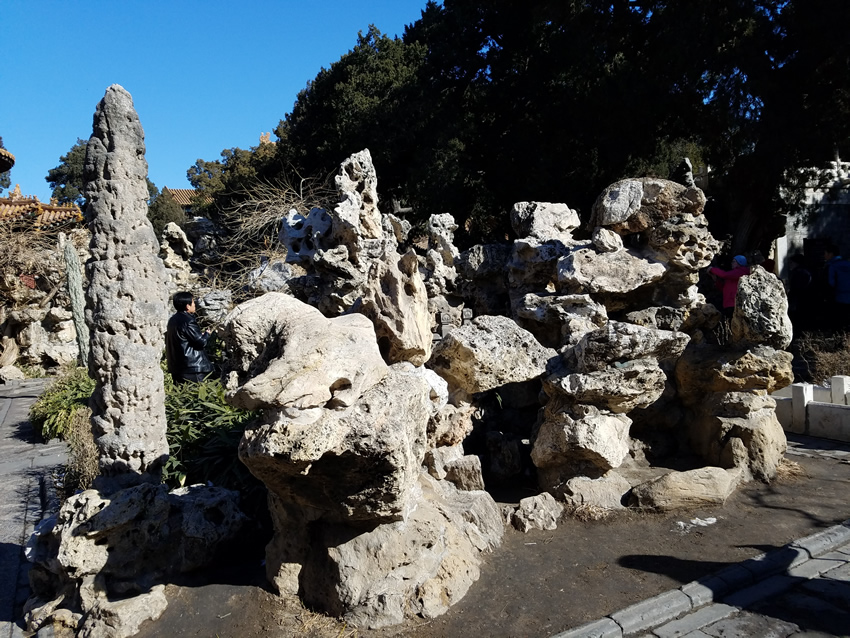
This is just one part of the "garden." The walkway from there had mosaic designs in one of the lanes.
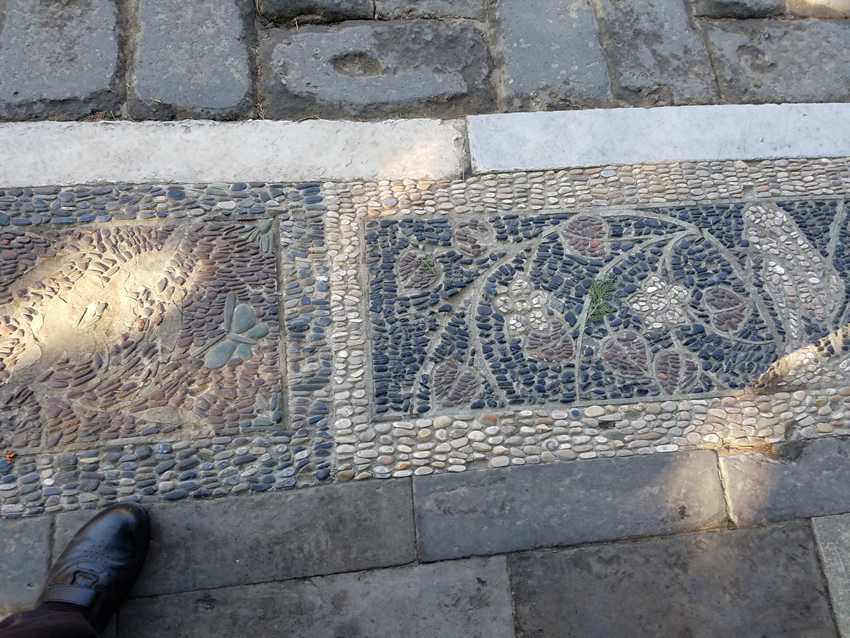
Lunch was in a hutong, ours near the Bell Tower. These are ancient living places, very small, with communal toilet and shower facilities. Men pay 10 yuan for a shower and women 16 (supposedly they take longer). The government is working to get rid of most of the hutongs (13 years ago we were split into groups of 5 and had a meal in one. I recall how proud the owners were of theirs.). The inhabitants, do not want to leave. What some have done to stay is to create a business in one part of the hutong so they can stay. Our group of 31 (I don’t know where the other group went) were served dumplings sitting crowded on stools at two tables. The dumplings were delicious and wouldn’t stop coming. Meat dumplings and vegetable ones. Like everyone else I made a pig of myself…
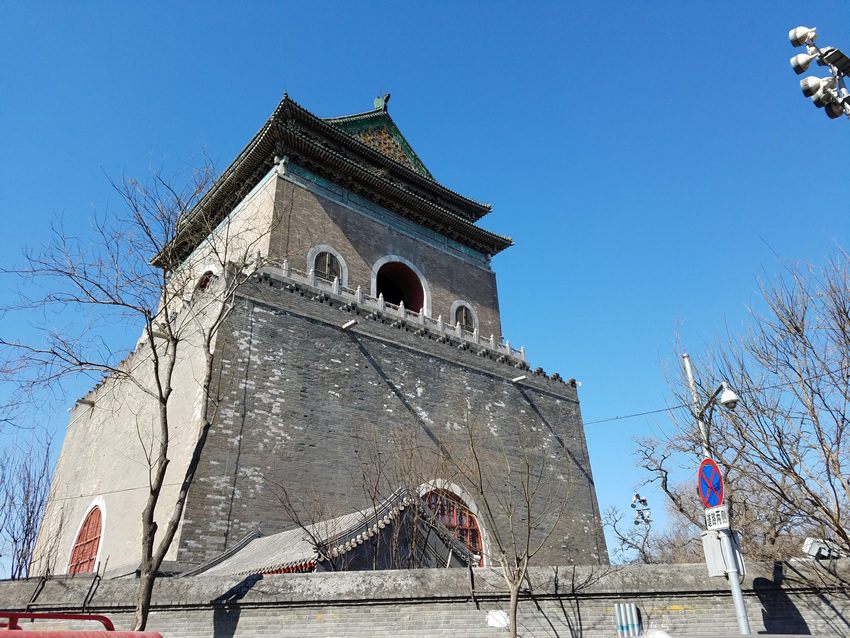
Bell Tower
A Chinese tea ceremony in a small tea shop in the Bell Tower followed. The bells in this tower use to be rung so the citizens would know what time it was. We experienced very small cups of 5 different blends of tea served very elegantly. The tea ceremony involves, heating the tea pot by pouring boiling water over it, then pouring the water over tea in a strainer creating a very mild tea. The pot is on a wooden box that allows the water to drain into it.
The Chinese have great faith in the healing powers of the various types of tea which I won’t discount. They are also, still quite superstitious.
Our guide, getting fed up with Western Medicine in which he found the doctor not much interested in him and who spent very little time with him, prescribed a medicine which s/he sold. He is now a fan of Chinese medicine. He reported that his daughter was very sick from all the pollution and after getting no help from Western medicine went to a Chinese doctor who did cupping (this involves using suction to place what look like small round beakers with a very small cylindrical sphere opening onto your body) and she recovered… He then went to a Chinese doctor himself and was diagnosed with “fatty liver.” When asked how this diagnosis was made, he replied “By the exam.” This is physical and involves not only time spent, but a laying on of hands. A special tea was prescribed and in 8 months he was pronounced cured. I believe that there is something to Eastern medicine, but this I have my doubts about.
The guide on the trip back to the port talked about Chinese health insurance. For $1.68 American (exchange rate is 6.86 yuans/dollar) a month one is insured against minor ailments, however, if you get a serious illness, you are on your own. That was his take, I cannot verify or discount it. However, what I had read before I came confirms this. According to our guide, the rural folk are plumb out of luck for any type of medical care. I don’t know how prevalent the Chinese barefoot doctors are, but they are probably using mostly Eastern Medicine, and I am not discounting it. I believe that there is value there.
The guide related many stories on the 3 hour trip back to the port. He reported that “Yes, we are taking your jobs.” But all the quality items are exported and the Chinese are left with the rejects, but at a much higher price than those who buy the goods in other countries pay. On a trip to New York he purchased 3 Lenovo Computers for much less than he would have paid in China…
Walmart in China has a very poor reputation because the items are of even lower quality than what we get. What shocked me was some of the rather negative comments he made about China. Talking like that 13 years ago would have gotten him in big trouble. Living there he cannot see any change, but in this respect, I could. I did not feel as circumscribed as I did 13 years ago, so their has been progress.
If you have a government job you are assured of a nice pension when you retire at age 60, but you may not have a passport. Working as he does for a private firm he can get a passport, but no retirement pension. He talked seriously about emigrating to Canada as he said many Chinese opt to do.
There are still many restrictions on movement. Population counts that are given are very inaccurate because they do not count the rural inhabitants. And, these folks cannot get “Certificates of Domesticity,” stating where one lives. On the way back to the port, on the other side of the expressway, we passed a checkpoint through which one cannot pass without this certificate. This despite, at one point, the government encouraging the workers to come to the cities to take jobs.
Early on in their quest for controlled capitalism, the government allowed many to get rich, thinking that they would then invest in China. Not so; they emigrated and stayed away… Buying a condo is still very expensive and all one gets is an expanse of space, often 900 to 1000 sq. feet. There are pipes, but no plumbing fixtures, let alone kitchen facilities. Owners have to put in walls, windows, doors, etc. And, you do not own, you are just leasing for 70 years…
He and his wife have 2 children, the government has relaxed the one child per family rule because of the unwritten rule that one take care of one’s parents. His main point was that every 5 years policies are changed and one never knows where one stands. Interestingly in the hotel where we stayed I picked up an English language paper and saw an article reporting that people who have 2 children are happier than those who have only one. Of course this is probably for Western consumption.
Currently there is a real estate boom, with the rich buying up buildings, waiting for the price to go up. The problem is that there are now ghost villages, that is, buildings with no occupants, we saw some of these between Beijing and the port. This has not changed in 13 years when the empty buildings were explained as being too expensive for most people to buy.
What got laughter from those in the bus was his statement that he was from a small city. The population there is “only 8 million.”
To regress to a bit of history, when the Japanese invaded in the 1930s, the Chinese government boxed up many of the historic relics that were in the Forbidden City and took them to Nanking where they buried them, denying them to the Japanese, Fast forward to Chang Kai Shek retreating to what was then Formosa (now Taiwan). He took as many of those treasures as he could with him. As it turns out, this preserved them. During the 10 year Cultural Revolution, many were destroyed by the Red Guards because the rulers were determined to wipe out the past…
Our guide reported on his first experiences in the West. The Chinese toilets flush very quietly and when in a NY hotel he first flushed a toilet the noise convinced him that he had broken it… Being an experimental sort, when he saw what he thought must be a machine that dispensed coke, he found that when he pushed the button out tumbled ice cubes… He had heard about Western vending machines but had never seen one. (He should visit Japan…) Another unrelated tidbit, they use “Big Potato” the same way that we use “Big Cheese” to refer to those in high positions.
I have already gone on too long, but these two days were filled with fascinating information. However, I was glad to get back to the ship and food that I could easily eat with a fork. And my kingdom for Western toilets; in public rest rooms there is usually only one, but 15 squatters and no toilet paper. If one is foresighted enough to bring one’s own, it must be deposited in a receptacle, not the toilet. On the ship it is safe to drink the water which we could not do in the hotel – even the Chinese will not drink their water.
Any of the above sound familiar...?